7A unit1 第四课时学案
- 格式:doc
- 大小:53.50 KB
- 文档页数:4
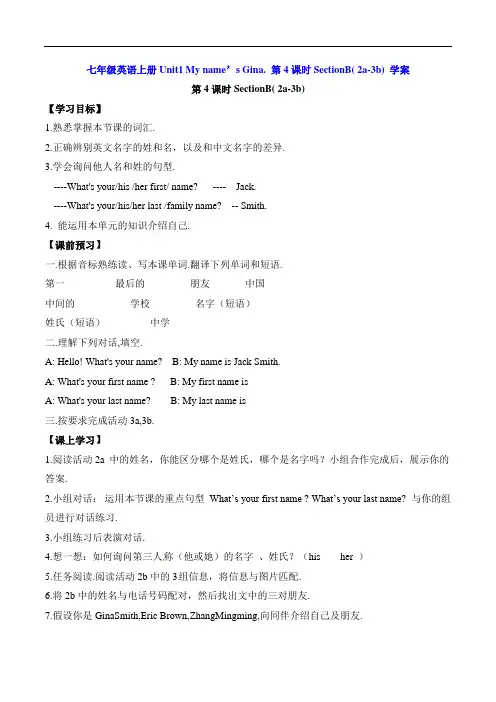
七年级英语上册Unit1 My name’s Gina. 第4课时SectionB( 2a-3b) 学案第4课时SectionB( 2a-3b)【学习目标】1.熟悉掌握本节课的词汇.2.正确辨别英文名字的姓和名,以及和中文名字的差异.3.学会询问他人名和姓的句型.----What's your/his /her first/ name? ---- Jack.----What's your/his/her last /family name? -- Smith.4. 能运用本单元的知识介绍自己.【课前预习】一.根据音标熟练读、写本课单词.翻译下列单词和短语.第一_______ 最后的_______ 朋友_______中国______中间的_________ 学校_________名字(短语)________姓氏(短语)_________中学_________二.理解下列对话,填空.A: Hello! What's your name? B: My name is Jack Smith.A: What's your first name ? B: My first name is________A: What's your last name? B: My last name is_______三.按要求完成活动3a,3b.【课上学习】1.阅读活动2a 中的姓名,你能区分哪个是姓氏,哪个是名字吗?小组合作完成后,展示你的答案.2.小组对话:运用本节课的重点句型What’s your first name ? What’s your last name? 与你的组员进行对话练习.3.小组练习后表演对话.4.想一想:如何询问第三人称(他或她)的名字、姓氏?(his her )5.任务阅读.阅读活动2b中的3组信息,将信息与图片匹配.6.将2b中的姓名与电话号码配对,然后找出文中的三对朋友.7.假设你是GinaSmith,Eric Brown,ZhangMingming,向同伴介绍自己及朋友.8. 集体核对3的句子.9.组内互查活动3b. 然后小组展示.【合作交流】1.在英语中如何拼写中国人的姓名?联合国教科文组织已做规定“一律按汉语拼音的写法.姓和名分开,姓在前,名在后”.现举例说明:(1)如果是单姓,名又是单字,则姓与名的第一个字母要大写,其余字母用小写.如:Li Lei 李雷.(2)如果是单姓,名是双字,则姓的第一个字母大写,名的第一个字母大写,名的双字合在一起算一个词,不得分开.如:Han Meimei韩梅梅.(3)如果是复姓,则把复姓字母连在一起,只是第一个字母大写,名字的拼写方法同上.如:Sima Zhao司马昭,Ouyang Yunsong欧阳云松.(4)如果名字里有可能造成音的混淆的拼写时,要用连字号“-”或隔音号“’”隔开.如:Yang Xi-an(Xi’an)杨西安,如写成Yang Xian就成了杨仙.2.观察下面的名字,小组讨论一下我们所学的英语名字和汉语名字有什么区别?比比哪组观察的仔细.例如:Jack Green 杰克.格林Zhang Jie 张杰Harry Poter 哈里波特Zeng Xiaoxian 曾小贤【展示汇报】各小组向全班展示合作交流的成果.【整理学案】梳理导学案,完善导学案上的内容.【达标检测】一.给下列姓和名分类Alan Jack Green Smith Miller Brown Mingming Zhang Gina MaryFirst name:__________________________________________Last name:___________________________________________二.单项选择( )1. ——What's _______ name? ——His name is Jack.A. herB. hisC. myD.your( )2. ——Is your name Jim Green?——_____________.A.Yes,I am.B.Yes,it isC.No, I’m notD.Yes,you are ( )3. ——What's her name? ——______ .A. a girlB. a boyC. LindaD.Jim( )4. ——What's the girl's name?——______ name is Mary.A. HisB. MyC. HerD.your( )5. ——What's the boy's name?——_______name is Francisco.A. HerB. HisC. It'sD. it( )6. His name is Bill Gates. We call him ______.A. Mr BillB. Mr GatesC. Mrs GatesD.Mrs Bill【作业布置】。
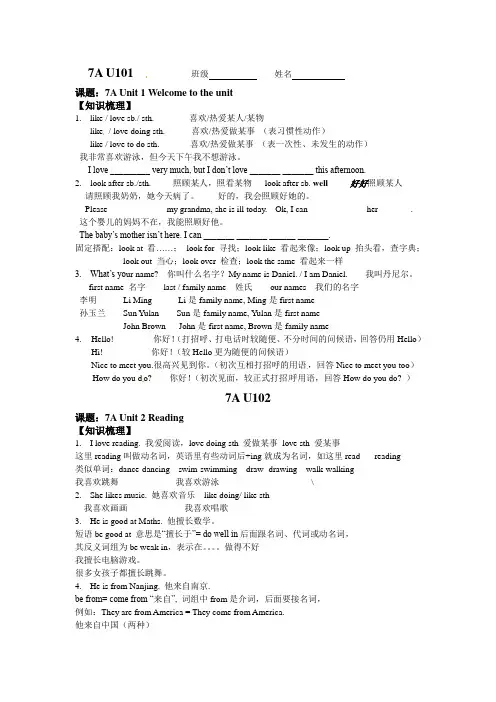
7A U101 班级姓名课题:7A Unit 1 Welcome to the unit【知识梳理】1.like / love sb./ sth. 喜欢/热爱某人/某物like/ love doing sth. 喜欢/热爱做某事(表习惯性动作)like / love to do sth. 喜欢/热爱做某事(表一次性、未发生的动作)我非常喜欢游泳,但今天下午我不想游泳。
I love _________ very much, but I don’t love _______ _______ this afternoon.2. look after sb./sth. 照顾某人,照看某物look after sb. well好好照顾某人--请照顾我奶奶,她今天病了。
--好的,我会照顾好她的。
--Please ______ ______ my grandma, she is ill today. --Ok, I can ______ ______ her _______. 这个婴儿的妈妈不在,我能照顾好他。
The baby’s mother isn’t here. I can _______ _______ ______ _______.固定搭配:look at 看……;look for 寻找;look like 看起来像;look up 抬头看,查字典;look out 当心;look over 检查;look the same 看起来一样3. What’s yo ur name? 你叫什么名字?My name is Daniel. / I am Daniel. 我叫丹尼尔。
first name 名字last / family name 姓氏our names 我们的名字李明Li Ming Li是family name, Ming是first name孙玉兰Sun Yulan Sun是family name, Yulan是first nameJohn Brown John是first name, Brown是family name4.Hello! 你好!(打招呼、打电话时较随便、不分时间的问候语,回答仍用Hello)Hi! 你好!(较Hello更为随便的问候语)Nice to meet you.很高兴见到你。
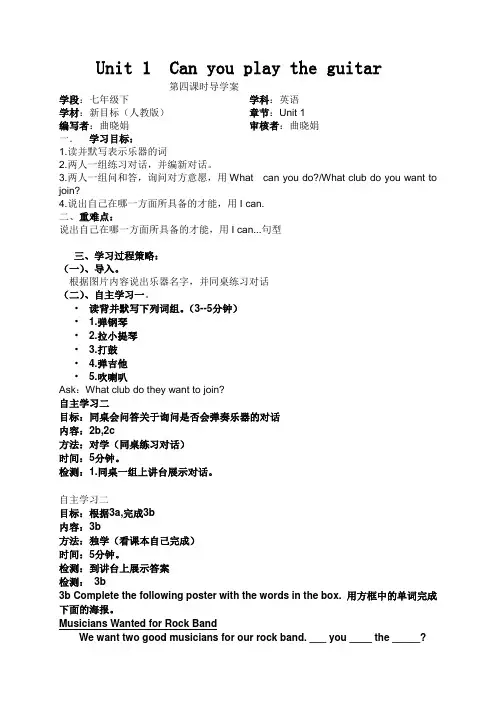
Unit 1 Can you play the guitar第四课时导学案学段:七年级下学科:英语学材:新目标(人教版)章节:Unit 1编写者:曲晓娟审核者:曲晓娟一.学习目标:1.读并默写表示乐器的词2.两人一组练习对话,并编新对话。
3.两人一组问和答,询问对方意愿,用What can you do?/What club do you want to join?4.说出自己在哪一方面所具备的才能,用I can.二、重难点:说出自己在哪一方面所具备的才能,用I can...句型三、学习过程策略:(一)、导入。
根据图片内容说出乐器名字,并同桌练习对话(二)、自主学习一。
•读背并默写下列词组。
(3--5分钟)• 1.弹钢琴• 2.拉小提琴• 3.打鼓• 4.弹吉他• 5.吹喇叭Ask:What club do they want to join?自主学习二目标:同桌会问答关于询问是否会弹奏乐器的对话内容:2b,2c方法:对学(同桌练习对话)时间:5分钟。
检测:1.同桌一组上讲台展示对话。
自主学习二目标:根据3a,完成3b内容:3b方法:独学(看课本自己完成)时间:5分钟。
检测:到讲台上展示答案检测:3b3b Complete the following poster with the words in the box. 用方框中的单词完成下面的海报。
Musicians Wanted for Rock BandWe want two good musicians for our rock band. ___ you ____ the _____?___ you ____? ___ you ____the _____?Please call Bill at 790-4230.Read this ad from the school magazine. Underline the things they want people to do for the school music festival. 阅读校刊上的这则广告。
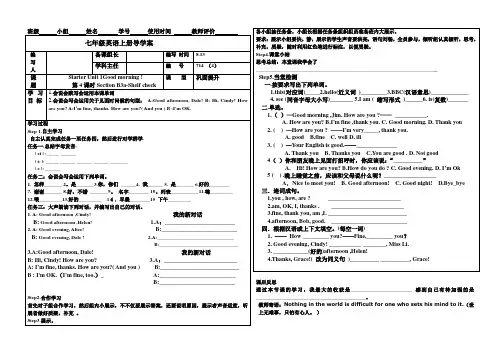
班级小组姓名学号使用时间教师评价七年级英语上册导学案编写人备课组长编写时间8.13学科主任编号714 (4)课题Starter Unit 1Good morning !第4课时Section B3a-Shelf check课型巩固提升学习目标1.会说会默写会运用本课单词2.会说会写会运用关于见面时问候的句型:A:Good afternoon, Dale! B: Hi, Cindy! How are you? A:I’m fine, thanks. How are you?( And you ) B :I'm OK.学习过程Step 1.自主学习自主认真完成任务一至任务四,然后进行对学群学.任务一:总结字母发音:| ei | :_____ ______| i: |: _____ ______ ______ ______ _______| e |: ______任务二:会说会写会运用下列单词。
1. 怎样_______ 2。
是_______3.你,你们______4. 我______ 5. 是_______ 6.好的________7. 谢谢_______ 8.好,不错_______9。
名字________ 10。
列表___________11.嗨_________12.喂_________13.好的_________14.早晨________15 下午_________任务三:大声朗读下列对话,并编写出自己的对话。
1. A: Good afternoon ,Cindy! 我的新对话B: Good afternoon ,Helen! 1.A:________________________2. A: Good evening, Alice! B:__________________________ B: Good evening, Dale ! 2.A:______________________________B:_______________________________ 3.A:Good afternoon, Dale! 我的新对话B: Hi, Cindy! How are you? 3.A:_________________________ A: I’m fine, thanks. How are you?( And you ) B:___________________________B : I'm OK.(I’m fine, too.)_ A:__________________________B:__________________________Step2.合作学习首先对子组合作学习,然后组内小展示,不不仅要展示答案,还要说明原因,展示者声音适度,听展者做好质疑,补充。
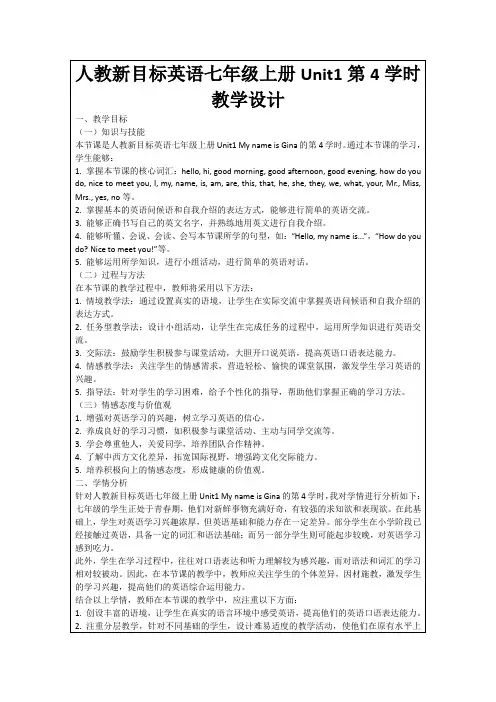
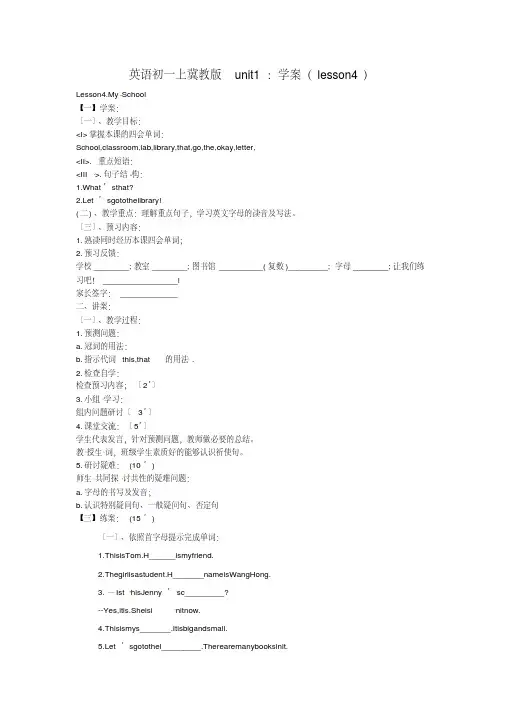
英语初一上冀教版unit1:学案(lesson4)Lesson4.My School【一】学案:〔一〕、教学目标:<I>掌握本课的四会单词:School,classroom,lab,library,that,go,the,okay,letter,<II>.重点短语:<III>.句子结构:1.What’sthat?2.Let’sgotothelibrary!(二)、教学重点:理解重点句子,学习英文字母的读音及写法。
〔三〕、预习内容:1.熟读同时经历本课四会单词;2.预习反馈:学校________;教室________;图书馆__________(复数)_________;字母________;让我们练习吧!_________________!家长签字:_____________二、讲案:〔一〕、教学过程:1.预测问题:a.冠词的用法:b.指示代词this,that的用法.2.检查自学:检查预习内容;〔2’〕3.小组学习:组内问题研讨〔3’〕4.课堂交流:〔5’〕学生代表发言,针对预测问题,教师做必要的总结。
教授生词,班级学生素质好的能够认识祈使句。
5.研讨疑难:(10’)师生共同探讨共性的疑难问题:a.字母的书写及发音;b.认识特别疑问句、一般疑问句、否定句【三】练案:(15’)〔一〕、依照首字母提示完成单词:1.ThisisTom.H______ismyfriend.2.Thegirlisastudent.H_______nameisWangHong.3.—Ist hisJenny’sc_________?--Yes,itis.Sheisi nitnow.4.Thisismys_______.Itisbigandsmall.5.Let’sgotothel_________.Therearemanybooksinit.〔二〕、be填空:1.I_____astudent.2.She_____ateacher.3.You_____aboy,butshe_____agirl.4.This_______alab.5.What_______thenameofyourschool?【四】测案〔10’〕阅读理解:。
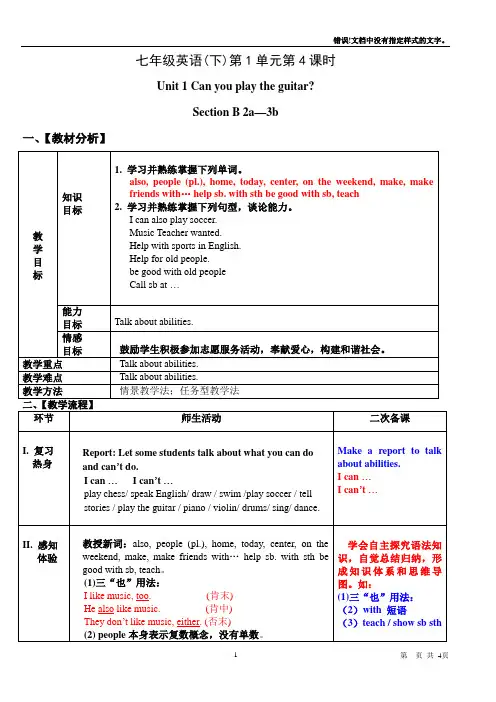
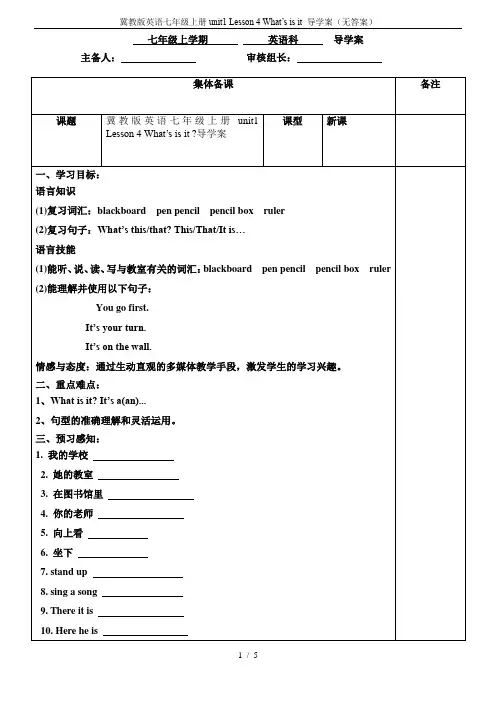
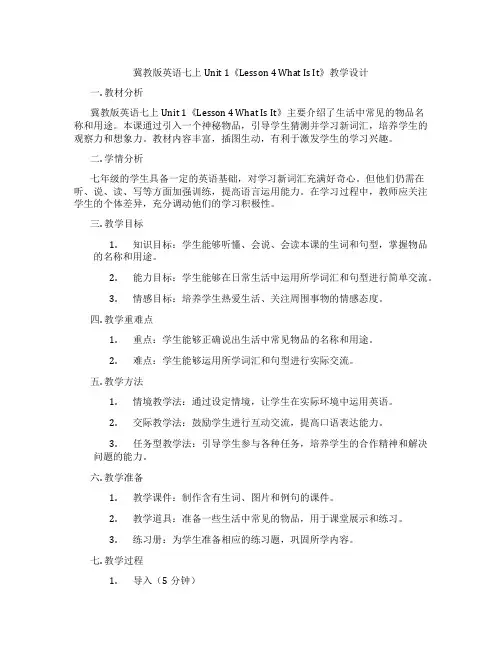
冀教版英语七上Unit 1《Lesson 4 What Is It》教学设计一. 教材分析冀教版英语七上Unit 1《Lesson 4 What Is It》主要介绍了生活中常见的物品名称和用途。
本课通过引入一个神秘物品,引导学生猜测并学习新词汇,培养学生的观察力和想象力。
教材内容丰富,插图生动,有利于激发学生的学习兴趣。
二. 学情分析七年级的学生具备一定的英语基础,对学习新词汇充满好奇心。
但他们仍需在听、说、读、写等方面加强训练,提高语言运用能力。
在学习过程中,教师应关注学生的个体差异,充分调动他们的学习积极性。
三. 教学目标1.知识目标:学生能够听懂、会说、会读本课的生词和句型,掌握物品的名称和用途。
2.能力目标:学生能够在日常生活中运用所学词汇和句型进行简单交流。
3.情感目标:培养学生热爱生活、关注周围事物的情感态度。
四. 教学重难点1.重点:学生能够正确说出生活中常见物品的名称和用途。
2.难点:学生能够运用所学词汇和句型进行实际交流。
五. 教学方法1.情境教学法:通过设定情境,让学生在实际环境中运用英语。
2.交际教学法:鼓励学生进行互动交流,提高口语表达能力。
3.任务型教学法:引导学生参与各种任务,培养学生的合作精神和解决问题的能力。
六. 教学准备1.教学课件:制作含有生词、图片和例句的课件。
2.教学道具:准备一些生活中常见的物品,用于课堂展示和练习。
3.练习册:为学生准备相应的练习题,巩固所学内容。
七. 教学过程1.导入(5分钟)教师展示一张神秘物品的图片,引导学生猜测:“What is it?”,激发学生的兴趣。
2.呈现(10分钟)教师展示神秘物品,并介绍其名称和用途,如:“This is a pen. It’s used for writing.”,同时板书关键词。
3.操练(10分钟)教师引导学生进行听力练习,播放相关音频,让学生回答问题。
如:“What is it?”,“It’s a…”。
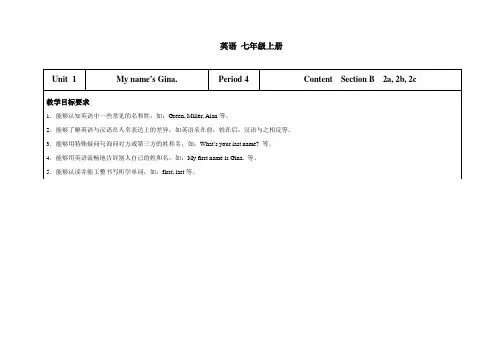
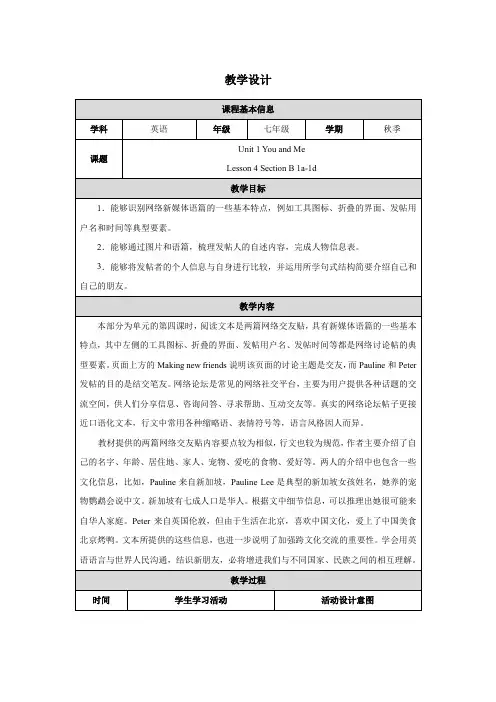
学习目标:能力目标能介绍自己和朋友的姓名和电话号码。
自主学习方案1.在教师的辅导下读认生词。
2.预习课本,找出重点短语和句子。
3.读记之后尝试完成自学导练题。
课堂导学方案Step 1 热身(Warm-up)1.教师自我介绍。
I’m Wang Shenli. My first name is Shenli. My last name is Wang.(让学生理解first name是名,last name 是姓。
)2.教师出示带姓名的图像(利用多媒体课件)eg: Eric Brown.告诉学生:Eric is his first name, Brown is his last name.让学生找到中文人名和英语人名的区别。
Step 2 导入(Lead in)1. T: What’s your first name?S:(教师可以帮助学生回答)Fang.T: What’s your last name?S: Wang.2.学生相互询问。
Step 3 呈现(Presentation)1.学生根据到目前为止所学的英文名字来完成2a。
2.教学2b。
阅读2b文章。
将文章三段分别与图片配对,然后在名字上画圈,在姓氏下划线。
3.教师放录音让学生跟读2b信息。
4.教学2c。
教师把姓名和电话号码分两栏排列,让学生将姓名和电话号码配对。
5.找出文章中的三对朋友。
Step 4 教与练(Teaching and practice)1.让学生结对编对话。
(根据2b内容)参考案例:A: What’s first name in A?B: It’s Jenny.A: What’s her telephone number?B: It’s 281-9176.2.用三幅图的信息练习对话,然后让2-3对学生表演对话。
Step 5 巩固(Consolidation)1.教师放2b课文录音,让学生不看课本写下所听到的姓名和电话号码。
2.根据所记下的信息练习对话。
Lesson 4 What’s is it ?一、教材分析本课是七年级第一册第一单元第4课,本文主要让学生学习各种学习用品的词汇,并学会如何对事物提问,借用教室内的各种事物,让学生参与游戏、对话、表演等活动,搞活课堂气氛,促使学生在生活中巩固旧知识,逐步掌握和拓展新内容。
1.教学目标●语言知识(1)复习词汇:blackboard pen pencil pencil box ruler(2)复习句子:What’s this/that? This/That/It is…●语言技能(1)能听、说、读、写与教室有关的词汇:blackboard pen pencil pencil box ruler(2)能理解并使用以下句子:You go first.It’s your turn.It’s on the wall.●情感与态度:通过生动直观的多媒体教学手段,激发学生的学习兴趣。
●学习策略:课堂教学始终坚持自主学习、合作探究、讨论练习等各个有效环节,让每一个学生都积极投入到课堂活动当中,培养学生用英语进行思考和做事情的意识。
2.教学重点: What is it? It’s a(an)...3.教学难点:句型的准确理解和灵活运用。
二、教学步骤Step I Class Opening(10 minutes)1.Sing a song “How Are You Today”2.Say something about the classroom.T: Do you have the pen/pencil/…? Today we will learn something about the classroom. (设计意图:图片导入,激起学生强烈的求知欲望)T: Look, boys and girls. What’s this ?/What’s that?Ss: It’s a blackboard/pen…T:Do you have one?S1:Yes ./No.T: What’s in your pencil box?S2:A pen./A ruler.T: Good job. Now make a new dialogue with your partner.SS: A: This is a ruler.B: Oh, it’s new/yellow/nice…(设计意图:通过师生问答、图片展示的方式展开复习,为后面教学做好铺垫)Step II. New Concepts (10 minutes)1. New words TeachingThe teacher and the students learn the new words by explaining the words.Eg.T: It’s long and thin. You can write with it. It’s a_________ .Ss :Pen.T: Where(哪里) is the blackboard?Ss: On the wall.(设计意图:通过师生问答、图片展示的方式学习本课的重点词汇,同时使学生对老师所提的特殊疑问句初步熟悉)2. Listen and read(设计意图:内容涵盖了本节课的重点词汇和句型,让学生在练习听力的过程中进一步掌握本课知识。
七年级英语上册第一单元(第四课时)学案人教新目标版第4课时 Section B 2a—3b【学习目标】1 掌握本课时句型:What’s your /his /her first/last name?My /His /Her first/last name is ……..2 学会使用单词 China, middle, school, friend.【学习重点、难点】熟练掌握本课时句型。
自主学习(提前预习,勤于归纳)自学所获(疑问和收获)1.回顾上节课的所学知识。
2.你能制作一张自己的个性名片吗?(可参考P6 的3a)3. 请对下面的姓名进行分类,在名字后写F ,在姓氏后写L.Nick Brown Jim Gina Miller LindaGreen Smith Alan Hand课堂展示与释疑 (我的舞台我做主)我的收获模块一自学展示1:复习上课时所学的数字的英文读音与拼写,并回顾上课时的重点句型。
2: 展示2a的答案。
模块二情景体验1.读2b,回答问题。
1)What’s Gina’s first name? Her first name is___________.2)What’s Dale’s last name? Her last name is____________.3)What’s Marry’s telephone number?Her telephone number is_____________2. Read and Match.(2c)3.处理3a模块三合作探究归纳总结如何用英语制作一张自己的学生卡,试着制作一张。
模块四学以致用根据你所制作的卡片,写几句英语来介绍一下自己。
达标测试错题分析一. 用所给词的正确形式填空.1.This is _________( I ) ID card.2.__________( he ) name is Jack.3.It’s _________( you ) telephone number.4.My last name ________( be ) White.5.I ________( be ) Peter Hunt.6.Nice __________( meet ) you.7.What_________( be ) your telephone number?8.My __________( one ) name is Jim.9. My friend_____(be) Li Hua10.Three and four ______(be) sever.二.根据首字母及句意填空:1.Our ________(学校) is beautiful(美丽).2. Li Hua and I are f____________.3. He is from C________. He is Chinese.4. He studies(学习)in No.1 M________ School.5. His l_______ name is Hua, and f______ name is Li.三.完形填空。
第四课时 Lesson4 What Is It?课时目标教学过程重点单词eraser 橡皮擦 guess 猜测 first 第一;首先 wall 墙重点短语guessing game 猜谜游戏 long and thin 又长又细 write with it 用它书写 on the wall 在墙上 big and black 又大又黑 look at... 看着重点句子1. What is it ?它是什么? 2 Is it a ruler? 它是直尺吗?3.You can write with it.你可以用它来书写。
4.It ’s on the wall. 它在墙上。
5.It ’s a blackboard! 它是一块黑板!6.Now it ’s your turn.现在轮到你了。
教学目标1.掌握本课时的重点单词。
2.学生了解并掌握一些有关学习用品介绍的词汇和句型。
教学难点1.掌握一些描述学习用品的词汇2.激发学生兴趣,学会介绍自己的学习用品。
3.熟练使用be 动词的三种形式:am 、is 、are 。
教师展示几张图片,提出以下问题,学生讨论并口头回答:What do you write and draw with?设计意图:以图片形式展示本课时涉及到的一些文具和教学工具,更加直观地体现本课时的的主图:询问物品并作答。
环节2 学习活动1.听录音,思考并口头回答下面几个问题:(1)The pencil is and . (2)The blackboard is on the .2.教师教读对话内容,然后讲解其中的重点短语和句子。
3.听录音,完成练习题1,给图片排序。
再听一遍,教师指导学生订正。
4.同桌一起练习。
参照书上的对话内容,相互出谜,让对方猜。
S1:What is...?S2:Is it a/an...?S2:You can... with itS2:It’s a...5.学生完成练习题3,根据图片和句子意思,填单词。
英语初一上冀教版unit1lesson4学案Lesson4学案【一】重点词汇Let,us,by,plane,take,slow,fast,cheap,expensive,train,than,sing,song,cost,much【二】重点句型1〕Let’s….2〕Howdoyougotoschool?【三】重点句子解析1.Let’sgotoBeijingbyplane,Mom!妈妈,咱们坐飞机去北京吧!〔1〕let’s是letus的缩写,后面跟动词原形。
例如:Let’sgooutforawalk.让我们出去散步吧。
let的否定句有两种。
假如宾语是第三人称用“Don’tlet…”;假如宾语是得意人称,那么用“Let…not”。
例如:Don’tlethimgoout.别让他出去。
Let’snotdoourhomeworkandlet’shavearest.让我们别做家庭作业了,让我们休息一下。
〔2〕介词by在此意为“乘……”,后面直截了当跟交通工具,表示去某地的方式,在句中一般作状语。
例如:bybus乘公共汽车bybike骑自行车bytrain乘火车byship(sea)乘轮船bytaxi乘出租汽车byplane(air)乘飞机2.Iwanttotakeabus.我想乘公共汽车。
〔1〕wanttodosth意为“想要做某事”。
takeabus表示乘公共汽车,作want的宾语。
〔2〕take+a+交通工具,是动词短语,强调动作;by+交通工具,强调方式,两短语意思相同,然而在句中的成分不同。
例如:IwilltakeaplanetoShenzhen.〔作谓语〕我将乘飞机去深圳。
Theycameherebybus.〔方式状语〕他们是坐公共汽车来那个地方的。
3.Abusisslow!Idon’twanttogobybus!公共汽车慢,我不想坐公共汽车去。
〔1〕不定冠词用于单数名词前,可表示“一”或“一个”,是数的概念,也能够指某一类人或事物中的一个或一类,但不具体说明和任何物。
Unit 1 Grammar(第4课时)主备人:赵美筌审核人:冯建霞时间:2013.9.4班级姓名【教材分析】Grammar是整个单元的核心部分,主要讲be动词的一般现在时变形并辅以练习。
在讲授新知识时就可以让学生参与其中,并适当地引导他们自己探索总结。
【学习目标】1. 能理解一般现在时的概念和用法。
2. 掌握一般现在时中be动词的用法。
3. 能运用be动词的一般现在时做简单的交流。
【教学重难点】1. 掌握重点单词和词组: over, classroom, over there2. 掌握重点句型:I am (not)… You / We / They are ( not)…He /She / It is (not)…Am I …? Yes, I am. / No, I am not.Are you / we / they…? Yes, you / we / they are.No, you / we / they aren’t.Is he / she / it…? Yes, he / she / it is.No, he / she / it is not.【温故预习】一、翻译下列句子:我来自中国。
他12 岁。
我们非常高兴。
她个子不高。
他们不在教室里。
你在七年级吗?是的,我是。
汤姆是你的同学吗?不,他不是。
二、自主探究1. be动词用于一般现在时,否定句怎样构成?2. be动词用于一般现在时,一般疑问句怎样构成?3. be动词用于一般现在时,对一般疑问句怎样作简略回答?回答时应注意什么?【课堂助学】Step 1 Presentation1. Present the simple present tense by language description.T: I am a teacher. You are students. We are in Grade 7.Write the sentences on the board. Explain to the Ss the usage of the simple present tense: When we talk about facts and states, we use the simple present tense.2. Create the situation with the sentences on the board, present meaning and usageof the verb to be in the simple present tense.3. Guide the Ss to read the form on P11. Learn the new words: over, classroom.Step 2 PracticeFill in the blanks with the correct form of the verb to be according to the real situation .1.I ____________ an English teacher.2.We ___________in the classroom.3.Our school ___________ big.4.You _________ middle school students.5.They _________ over there.6.It _______ a dog.7.He ______ in Class 2. Grade 3.8.She _______ on the playground now.Step 3 Presentation1. Present the negative sentences using the sentences above.T: I am an English teacher. I am not a Maths teacher. We are in the classroom. We are not in the park. We aren’t in the park. Our school is big. It is not small.Write the examples on the Bb.1.Arouse the Ss to find out the rule of changing into the negative sentences: Add ‘not’after ‘be’.2.Arouse the Ss to find the abbreviations of ‘are’, ‘is’and ‘not’, and tell them that‘am’ and ‘not’ don’t have an abbreviation.Step 4 PracticeGet Ss to make give some examplesStep 5 Presentation1. Present the general questions by playing a game. e.g. Is this book yours? Are you twelve? Are you good at English? Get Ss to answer ‘Yes, …’ or ‘No, …’2. Give some more examples, arouse Ss to find the rule of changing into Yes or No questions: Put the verb to be to at the beginning of the sentence.3. Guide the Ss to read the form on P11 and sum up the rules.Step 6 PracticeGet Ss to make some more sentences by asking and answering Yes / No questions. 【当堂训练】一、写出下列词或短语相应的be 动词1. she2. you and I _________3. I _________4. our teachers ______5. her good friend______6. Millie and Amy_____7. their room ________ 8. the name of her cat______ 9. the apples _______二、用be 动词的适当形式填空1. This ________ Simon’s notebook.2. Tom and Bob ________ brothers.3. —_______ they good at Maths? —Yes, they ________.4. I _______ Chen Dan. My English name _______ Daniel.5. —______ you in Grade 7? —Yes, I ________.6. Our school is beautiful, I ______happy at school.7. Amy and Simon _________ new friends.8. I like reading. It ________ great fun.9. Miss Liu_______ our English teacher. She _______ young.10. My parents love me. They _______ happy when I _______ happy.三、将下列句子改成否定句和一般疑问句,并作肯定和否定回答1. I am good at swimming.2. The bike is under the tree.3. The twins are at home.【巩固延伸】一、根据提示写出单词。
1. The ______ (教室) in our school are all big, bright and clean.2. Do ______ (他们) often play games after school?3. Are they all our ______ (同学)?4. There are forty-two s_______ in our class.5. —Are you h______ today? —No, I am not. I am a little sad.二、用be动词的适当形式填空。
1.I _____ tall and strong.2. Millie’s parents _____ workers in a shoe factory.3. —_____ you Daniel? —Yes, I _____.4. This _____ my friend. He _____ American.5. Jim _____ not in Class 2.6. _____ it an apple?7. Let’s _____ good friends!8. _____ Kate at home with her brother?三、单项选择1. _____ am a strong boy with short hair.A. IB. MeC. MyD. We2. This film _____ very interesting. I want to _____ it againA. is, watchB. am, watchC. are, seeD. be, see3. —_____ your classroom big or small? —It _______big.A. Are, isB. Is, isC. Is, areD. Are, are4. —Hello! Are you his father ? —_____. I’m his uncle.A. Yes, I amB. No, I’m notC. Yes, I’m notD. No, I am5. Which is not right?A. I am = I’mB. You are = You’reC. They are = They’reD. It is = its四、根据汉语意思完成句子,每空一词1. 我们的老师很好,吴老师是个好老师。
Our teachers __________ nice. Mr Wu _________ a good teacher.2. 看,Sandy在那儿。